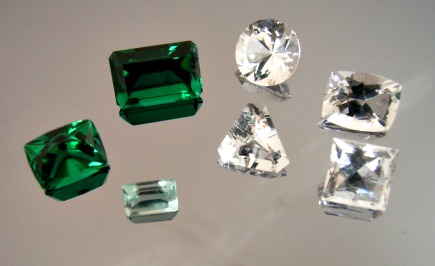 |
| ロシアの熱水合成エメラルド、メイン州のゴッシェナイト、ブルマードの緑柱石 Russian synthetic emeralds, Goshenite of Maine, Beryl from Brumado |
新着宝石展示室(New Gemstone
Gallery)
July 2006-2
緑柱石(Beryls)
ロシアの熱水合成エメラルド、メイン州のゴッシェナイト、ブルマードの緑柱石
Russian synthetic emeralds, Goshenite of Maine, Beryl from Brumado
ブラジル・ブルマードの緑柱石(A beryl of Brumado, Brazil)
ブラジル、バイア州のブルマードには推定埋蔵量3億トンと世界有数のマグネサイト(菱苦土石)の鉱山があります。
が鉱物コレクターにとっては、マグネサイトの晶洞中に発見される水晶の日本式双晶やウヴァイト、緑柱石、トパーズ、それに稀なウラン鉱物等の素晴らしい結晶の方に興味がそそられます。
ブルマードは先カンブリア紀の主に片岩と片麻岩から成る層に貫入した花崗岩と緑閃石岩脈との基盤岩層があり、その上を変成作用を受けた厚さが450mを越える苦灰岩に薄い珪質岩が入り混じった層が覆っています。
こうした複雑な岩盤層に3度に及ぶ熱水の貫入があり、ドロマイトからマグネサイトへの交代変成作用によって鉱床が形成されたと考えられています。 この作用に伴いドロマイトーマグネサイト層の亀裂や晶洞の中に水晶や緑柱石等の鉱物結晶が成長しました。
写真の緑柱石は淡青色のアクアマリンですが、チェルシー・フィルターを通してかすかにピンク色に発色し、クロムを含むエメラルドの成り損ないでもあることが分かりました。
実はブルマードはブラジルで最も古くエメラルドが発見された場所でもあります。 1912−13年にはかなり豊かなエメラルド鉱床が発見され20年ほどの間に5ヘクタール程の広さの鉱区で採掘が行われました。
宝石質ではありませんが1923年に採集された7.7cm 175.3g と 12.3cm, 128.6g の透明な淡緑色の結晶がシカゴのフィールド博物館に展示されています。緑柱石(Beryl)
0.76ct 6.4x4.2mm
Brumado, Bahia, Brasil
Although Brumado, Bahia, Brazil is one of the largest magnesite deposit with ore reserve of 300 millions of tons, for the mineralogist, it is, above all else, a famous locality from which have come extraordinary specimens of twinned quartz, magnesite,, beryl, topaz, rare urnium minerals and more. The geology of Brumado are consists primarily of Precambrian bsement rocks, mainly gray gneiss and schists with grnitic intrusions and amphibolite dyke, all dated Lower to Middle Pre-cambrian. Overlying these rocks is a metamorphosed sequence of dolomite and quartzite correlated in manyways with the Minas series. A sequence of dolomite strata more than 450m thick forms the lower unit which directly overlies the basement complex.It consists mainly of dolomite with subordinate thin layers of quartzite. There has been several hydrothermal intrusions through fissures and breccia zones of this basic rocks, which resulted in mineralizations of magnesite as a replacement of dolomite and as an alteration of quartz and silica minerals to magnesium minerals. During mineralization the ore forming solutions minerals deposited changed in compositions.
Photo shows pale blue aquamarine, but through chelsea filtor, it is slightly colored by pale pink to tell that this stone is an emerald, containing minor amount of chrome. Brumado is the locality where emeralds were first discovered on the west side of the Piraja Valley, in Brazil, around 1912-13. They were recovered from quarry, surface pits, and alluvial placer deposits. Five hectares of ground were panned and sieved during the following 20 years. In 1923, several large emeralds and other specimens were obtained in the course of and expedition made for the Field Museum of Chicago. Two of the best emeralds, which are on exhibit at the Field Museum of Chicago, weigh 175.3 and 128.6g. The former is 7.7cm long and the latter is 12.3cm long. They are transparent and of a pale emerald-green color.
メイン州のゴッシェナイト(Goshenite of Maine, U.S.A.)
2.80ct ø9.45mm 2.62ct 9.95x7.70mm 2.50ct 7.70mm 1.53ct 8.15mm Greenwood, Maine, U.S.A.
ゴッシェナイトは不純物が少なく無色の緑柱石ですから世界中のペグマタイト鉱脈で発見されますが、宝石として研磨されるような大きく包有物の少ない結晶の産地となると大変限られます。
ペグマタイト宝石の宝庫であるブラジルやパキスタン等が主な産地ですが、アメリカ北東部のペグマタイトには何故かポルックス石やゴッシェナイト等、一般的ではない無色透明な宝石が発見されます。
ゴッシェナイトの名もマサチューセッツ州 Goshen にて1844年に発見されたことに因む命名です。
今回入手したのは同じペグマタイト地帯にあるメイン州産です。
写真は背景に灰色や黒い影が映っていますが肉眼ではクリスタル・クリアーと呼べる透明な美しさが見事です。
Goshenite is a colorless beryl variety with very low impurity. Although discovered commonly in world's pegmatite veins, facetable gem crystals are quite rare. Brazil and Pakistan are the main locality, but north-eastern part of North America is relatively abundant with rare colorless gemstones such as, pollucite and goshenite, as it's name derives from pegmatite vein near the town of Goshen, Massachusetts, where this colorless variety was first discovered in 1844. Although grayish and black shadow seen in photos, stones are actually crystal clear with naked eye.
ロシアの熱水合成エメラルド(Russian hydrothermal synthetic emeralds)
初期のロシア製熱水合成エメラルド
Early Russian hydrothermal synthetic emeralds2.70ct 9.3x7.2mm 5.17ct 12.0x8.0mm Earth Science Acadmy, Novosibirsk, Russia
ロシアはシベリア・ノヴォシビルスクにある地球科学アカデミー研究所にて熱水法による合成エメラルドの量産技術を確立し、1989年ごろから製品が市場に流通し始めました。
既に熱水法合成エメラルドはアメリカのリンデ社やリージェンシー社、オーストラリアのバイロン社等が市場にありましたが,ロシア産は特有の結晶成長歪を伴うことで天然や他の熱水法とは容易に識別できるのが特徴です。
写真の拡大したルース写真の底面にはっきりと見られる雁木模様が他には見られない特徴です。
これは3ヶ月程で100カラットの大きさの結晶を高速成長させるために特定の結晶軸に成長歪が起こるためです。
さらに、主に鉄とヴァナジウムとが発色材として用いられているためにチェルシー・フィルターを通しても赤く見えないことももう一つの特徴です。
この二つの特徴により他の合成や天然のエメラルドとは容易に識別できるのがロシアの熱水法合成エメラルドで、1996年ごろまでに製造販売されました。
今回、たまたま正体不明の古い流通在庫を入手しましたが、前述の特徴によって初期のロシア製の熱水法合成エメラルドと判明しました。
Russia has established the mass-production technology of synthetic emerald by hydrothermal method at Science Academy of Novosibirsk in 1989. Already synthetic emaralds by same method have been available in the market from Linde, Regency, U.S.A. and Biron, Australia, Russian one could be easily identified from natural and others by charactristic patterns, visible with unaided eye. This unique angular growth pattern happenes due to an accelerated crystal growth. In addition, Russian hydrothermal emerald is colored not by chorome but mainly by iron and vanadium, resulting no reaction through chelsea filtor. This type of synthetic emerald has been produced until 1996.
I have obtained these two unidentified stones and found them as the first generation of Russian hydrothermal synthetics thanks to the above mentioned charaters.
Top Gem Hall New Gemstone Gallery